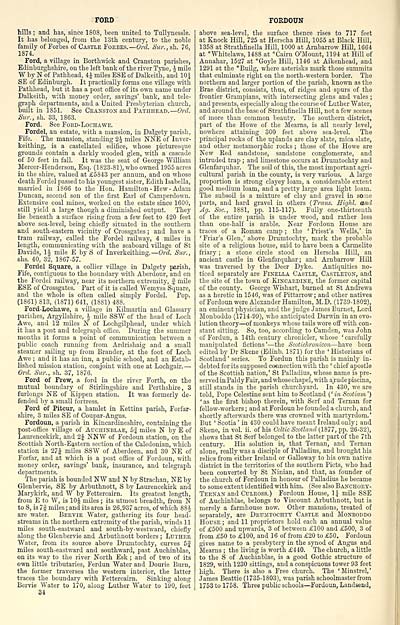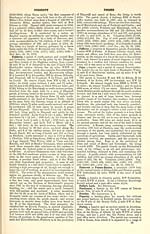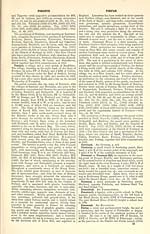Ordnance gazetteer of Scotland > Volume 3
(98) Page 34
Download files
Complete book:
Individual page:
Thumbnail gallery: Grid view | List view

FORD
hills ; and has, since 1808, been united to TuUynessle.
It has belonged, from the 13th century, to the noble
family of Forbes of Castle Foeees. — Ord. Siir., sh. 76,
1874.
Ford, a village in Borthwick and Cranston parishes,
Edinburghshire, on the left bank of the river Tyne, J mile
"W by N of Pathhead, 4J miles ESE of Dalkeith, and 10 J
SE of Edinburgh. It practically forms one village Avith
Pathhead, but it has a post office of its own name under
Dalkeith, with money order, savings' bank, and tele-
graph departments, and a United Presbyterian church,
birilt in 1851. See Ckanston and Pathhead. — Oi-d.
Sur., sh. 33, 1863.
Ford. See Fokd-Lochawe.
Fordel, an estate, with a mansion, in Dalgety parish,
Fife. The mansion, standing 2J miles NNE of Inver-
keithing, is a castellated edifice, whose picturesque
grounds contain a darkly wooded glen, with a cascade
of 50 feet in fall. It was the seat of George William
Mercer-Henderson, Esq. (1823-81), who o-\vned 1955 acres
in the shire, valued at £5843 per annum, and on whose
death Fordel passed to his youngest sister, Edith Isabella,
married in 1S66 to the Hon. Hamilton - Hew - Adam
Duncan, second son of the first Earl of CamperdoAvn.
Extensive coal mines, worked on the estate since 1600,
still yield a large though a diminished output. They
lie beneath a surface rising from a few feet to 420 feet
above sea-level, being chielly situated in the southern
and south-eastern vicinity of Crossgates ; and liave a
tram railway, called the Fordel railway, 4 miles in
length, communicating with the seaboard village of St
Davids, li mile E by S of Inverkeithing. — Ord. Sur.,
shs. 40, 32, 1867-57.
Fordel Square, a collier village in Dalgety parish,
Fife, contiguous to the boundary with Aberdour, and on
the Fordel railway, near its northern extremity, f mile
ESE of Crossgates. Part of it is called Wemyss Square,
and the whole is often called simply Fordel. Pop.
(1861) 813, (1871) 641, (1881) 488.
Ford-Lochawe, a village in Kilmartin and Glassary
parishes, Argyllshire, J mile SSW of the head of Loch
Awe, and 12 miles N of Lochgilphead, under which
it lias a post and telegraph oflice. During the summer
months it forms a point of communication between a
public coach running from Ardrishaig and a small
steamer sailing up from Brander, at the foot of Loch
Awe ; and it has an inn, a public school, and an Estab-
lished mission station, conjoint with one at Lochgair. — •
Ord. Sur., sh. 37, 1876.
Ford of Frew, a ford in the river Forth, on the
mutual boundary of Stirlingshire and Perthshire, 3
furlongs NE of Kippen station. It was formerly de-
fended by a small fortress.
Ford of Pitcur, a hamlet in Eettins parish, Forfar-
shire, 3 miles SE of Coupar-Angus.
Fordoun, a parish in Kincardineshire, containing the
post-oifice village of Auohinblae, 5| miles N by E of
Laurencekirk, and 2J NNW of Fordoun station, on the
Scottish North-Eastern section of the Caledonian, which
station is 27J miles SSW of Aberdeen, and 30 NE of
Forfar, and at which is a post ofiice of Fordoun, with
money order, savings' bank, insurance, and telegraph
departments.
The parish is bounded NW and N by Strachan, NE by
Glenbervie, SE by Arbuthnott, S by Laurencelurk and
Marykirk, and W by Fettercairn. Its gi'eatest length,
from E to W, is lOJ miles ; its utmost breadth, from N
to S, is 7g miles ; and its area is 26,937 acres, of which 88i
are water. Beevie Water, gathering its four head-
streams in the northern exti'emity of the parish, winds 11
mUes south-eastward and south-by-westward, chiefly
along the Glenbervie and Arbuthnott borders ; Litthek
Water, from its source above Drumtochty, curves 5|
miles south-eastward and southward, past Auchinblae,
on its way to the river North Esk ; and of two of its
own little tributaries, Ferdun Water and Dourie Burn,
the former traverses the western interior, the latter
traces the boundary with Fettercairn. Sinking along
Bervie Water to 170, along Luther Water to 190, feet
84
FOEDOUN
above sea-level, the surface thence rises to 717 feet
at Knock Hill, 725 at Herscha HDl, 1055 at Black Hill,
1358 at Strathfinella Hill, 1000 at Arnbarrow Hill, 1664
at *Whitelaws, 1488 at *Cairn O'Mouut, 1194 at HiU of
Annahar, 1527 at *Goyle Hill, 1146 at Aikenhead, and
1291 at the *Builg, where asterisks mark those summits
that culminate right on the north-western border. The
northern and larger portion of the parish, known as the
Brae district, consists, thus, of ridges and spurs of the
frontier Grampians, with intersecting glens and vales ;
and presents, especially along the course of Luther Water,
and around the base of Strathfinella HUl, not a few scenes
of more than common beauty. The southern district,
part of the Howe of the Mearns, is all nearly level,
nowhere attaining 300 feet above sea-level. The
principal rocks of the uplands are clay slate, mica slate,
and other metamorphic rocks ; those of the Howe are
New Red sandstone, sandstone conglomerate, and
intruded trap ; and limestone occurs at Drumtochty and
Glenfarquhar. The soil of this, the most important agri-
cultural parish in the county, is very various. A large
proportion is strong clayey loam, a considerable extent
good medium loam, and a pretty large area light loam.
The subsoil is a mixture of clay and gravel in some
parts, and hard gravel in others (Trans. Highl. and
Ag. Soc, 1881, pp. 115-117). Fully one-thirteenth
of the entire parish is under wood, and rather less
than one-half is arable. Near Fordoun House are
traces of a Roman camp; the 'Priest's AVells,' in
'Friar's Glen,' above Drumtochty, mark the probable
site of a religious house, said to have been a Carmelite
friary ; a stone circle stood on Herscha HiU, an
ancient castle in Glenfarquhar; and Arnbarrow Hill
was traversed by the Deer Dyke. Antiquities no-
ticed separately are Finella Castle, Castleton, and
the site of the town of Kincardine, the former capital
of the county. George Wislrart, burned at St Andrews
as a heretic in 1546, was of Pittarrow; and other natives
ofFordoun were Alexander Hamilton, M.D. (1739-1802),
an eminent physician, and the judge James Burnet, Lord
Monboddo (1714-99), who anticipated Darwin in an evo-
lution theory — of monkeys whose tails wore off with con-
stant sitting. So, too, according to Camden, was John
of Fordun, a 14th century chronicler, whose 'carefully
manipulated fictions' — the Scotichronicon — have been
edited by Dr Skene (Edinb. 1871) for the ' Historians of
Scotland ' series. To Fordun this parish is mainly in-
debted for its supposed ccmnection with the ' chief apostle
of the Scottish nation,' St Palladius, whose name is pre-
served in Paldy Fair, and whose chapel, with a'rude piscina,
still stands in the parish churchyard. In 430, we are
told. Pope Celestine sent him to Scotland ( ' in Scotiam ')
'as the first bishop therein, with Serf and Ternan for
fellow- workers ; and at Fordoun he founded a church, and
shortly afterwards there was crowned with martjrrdom.'
But ' Scotia ' in 430 could have meant Ireland only; and
Skene, in vol. ii. of his Celtic Scotland (ISII ,^^. 26-32),
shows that St Serf belonged to the latter part of the 7th
century. His solution is, that Ternan, and Ternan
alone, really was a disciple of Palladius, and brought his
relics from either Ireland or Galloway to his own native
district in the territories of the southern Picts, who had
been converted by St Ninian, and that, as founder of
the church of Fordoun in honour of Palladius he became
to some extent identified with him. (See also Banohokt-
Ternan and CuLROSS.) Fordoun House, Ij mUe SSE
of Auchinblae, belongs to Viscount Arbuthnott, but is
merely a farmhouse now. Other mansions, treated of
separately, are Drumtochty Castle and Monboddo
House ; and 11 proprietors hold each an annual value
of £500 and upwards, 3 of between £100 and £500, 3 of
from £50 to £100, and 16 of from £20 to £50. Fordoun
gives name to a presbytery in the synod of Angus and
Mearns ; the living is worth £440. The church, a little
to the S of Auchinblae, is a good Gothic structure of
1829, with 1230 sittings, and a conspicuous tower 93 feet
high. There is also a Free church. The ' Minstrel, '
James Beattie (1735-1803), was parish schoolmaster from
1753 to 1758. 'Three public schools — Fordoun, Landsend,
hills ; and has, since 1808, been united to TuUynessle.
It has belonged, from the 13th century, to the noble
family of Forbes of Castle Foeees. — Ord. Siir., sh. 76,
1874.
Ford, a village in Borthwick and Cranston parishes,
Edinburghshire, on the left bank of the river Tyne, J mile
"W by N of Pathhead, 4J miles ESE of Dalkeith, and 10 J
SE of Edinburgh. It practically forms one village Avith
Pathhead, but it has a post office of its own name under
Dalkeith, with money order, savings' bank, and tele-
graph departments, and a United Presbyterian church,
birilt in 1851. See Ckanston and Pathhead. — Oi-d.
Sur., sh. 33, 1863.
Ford. See Fokd-Lochawe.
Fordel, an estate, with a mansion, in Dalgety parish,
Fife. The mansion, standing 2J miles NNE of Inver-
keithing, is a castellated edifice, whose picturesque
grounds contain a darkly wooded glen, with a cascade
of 50 feet in fall. It was the seat of George William
Mercer-Henderson, Esq. (1823-81), who o-\vned 1955 acres
in the shire, valued at £5843 per annum, and on whose
death Fordel passed to his youngest sister, Edith Isabella,
married in 1S66 to the Hon. Hamilton - Hew - Adam
Duncan, second son of the first Earl of CamperdoAvn.
Extensive coal mines, worked on the estate since 1600,
still yield a large though a diminished output. They
lie beneath a surface rising from a few feet to 420 feet
above sea-level, being chielly situated in the southern
and south-eastern vicinity of Crossgates ; and liave a
tram railway, called the Fordel railway, 4 miles in
length, communicating with the seaboard village of St
Davids, li mile E by S of Inverkeithing. — Ord. Sur.,
shs. 40, 32, 1867-57.
Fordel Square, a collier village in Dalgety parish,
Fife, contiguous to the boundary with Aberdour, and on
the Fordel railway, near its northern extremity, f mile
ESE of Crossgates. Part of it is called Wemyss Square,
and the whole is often called simply Fordel. Pop.
(1861) 813, (1871) 641, (1881) 488.
Ford-Lochawe, a village in Kilmartin and Glassary
parishes, Argyllshire, J mile SSW of the head of Loch
Awe, and 12 miles N of Lochgilphead, under which
it lias a post and telegraph oflice. During the summer
months it forms a point of communication between a
public coach running from Ardrishaig and a small
steamer sailing up from Brander, at the foot of Loch
Awe ; and it has an inn, a public school, and an Estab-
lished mission station, conjoint with one at Lochgair. — •
Ord. Sur., sh. 37, 1876.
Ford of Frew, a ford in the river Forth, on the
mutual boundary of Stirlingshire and Perthshire, 3
furlongs NE of Kippen station. It was formerly de-
fended by a small fortress.
Ford of Pitcur, a hamlet in Eettins parish, Forfar-
shire, 3 miles SE of Coupar-Angus.
Fordoun, a parish in Kincardineshire, containing the
post-oifice village of Auohinblae, 5| miles N by E of
Laurencekirk, and 2J NNW of Fordoun station, on the
Scottish North-Eastern section of the Caledonian, which
station is 27J miles SSW of Aberdeen, and 30 NE of
Forfar, and at which is a post ofiice of Fordoun, with
money order, savings' bank, insurance, and telegraph
departments.
The parish is bounded NW and N by Strachan, NE by
Glenbervie, SE by Arbuthnott, S by Laurencelurk and
Marykirk, and W by Fettercairn. Its gi'eatest length,
from E to W, is lOJ miles ; its utmost breadth, from N
to S, is 7g miles ; and its area is 26,937 acres, of which 88i
are water. Beevie Water, gathering its four head-
streams in the northern exti'emity of the parish, winds 11
mUes south-eastward and south-by-westward, chiefly
along the Glenbervie and Arbuthnott borders ; Litthek
Water, from its source above Drumtochty, curves 5|
miles south-eastward and southward, past Auchinblae,
on its way to the river North Esk ; and of two of its
own little tributaries, Ferdun Water and Dourie Burn,
the former traverses the western interior, the latter
traces the boundary with Fettercairn. Sinking along
Bervie Water to 170, along Luther Water to 190, feet
84
FOEDOUN
above sea-level, the surface thence rises to 717 feet
at Knock Hill, 725 at Herscha HDl, 1055 at Black Hill,
1358 at Strathfinella Hill, 1000 at Arnbarrow Hill, 1664
at *Whitelaws, 1488 at *Cairn O'Mouut, 1194 at HiU of
Annahar, 1527 at *Goyle Hill, 1146 at Aikenhead, and
1291 at the *Builg, where asterisks mark those summits
that culminate right on the north-western border. The
northern and larger portion of the parish, known as the
Brae district, consists, thus, of ridges and spurs of the
frontier Grampians, with intersecting glens and vales ;
and presents, especially along the course of Luther Water,
and around the base of Strathfinella HUl, not a few scenes
of more than common beauty. The southern district,
part of the Howe of the Mearns, is all nearly level,
nowhere attaining 300 feet above sea-level. The
principal rocks of the uplands are clay slate, mica slate,
and other metamorphic rocks ; those of the Howe are
New Red sandstone, sandstone conglomerate, and
intruded trap ; and limestone occurs at Drumtochty and
Glenfarquhar. The soil of this, the most important agri-
cultural parish in the county, is very various. A large
proportion is strong clayey loam, a considerable extent
good medium loam, and a pretty large area light loam.
The subsoil is a mixture of clay and gravel in some
parts, and hard gravel in others (Trans. Highl. and
Ag. Soc, 1881, pp. 115-117). Fully one-thirteenth
of the entire parish is under wood, and rather less
than one-half is arable. Near Fordoun House are
traces of a Roman camp; the 'Priest's AVells,' in
'Friar's Glen,' above Drumtochty, mark the probable
site of a religious house, said to have been a Carmelite
friary ; a stone circle stood on Herscha HiU, an
ancient castle in Glenfarquhar; and Arnbarrow Hill
was traversed by the Deer Dyke. Antiquities no-
ticed separately are Finella Castle, Castleton, and
the site of the town of Kincardine, the former capital
of the county. George Wislrart, burned at St Andrews
as a heretic in 1546, was of Pittarrow; and other natives
ofFordoun were Alexander Hamilton, M.D. (1739-1802),
an eminent physician, and the judge James Burnet, Lord
Monboddo (1714-99), who anticipated Darwin in an evo-
lution theory — of monkeys whose tails wore off with con-
stant sitting. So, too, according to Camden, was John
of Fordun, a 14th century chronicler, whose 'carefully
manipulated fictions' — the Scotichronicon — have been
edited by Dr Skene (Edinb. 1871) for the ' Historians of
Scotland ' series. To Fordun this parish is mainly in-
debted for its supposed ccmnection with the ' chief apostle
of the Scottish nation,' St Palladius, whose name is pre-
served in Paldy Fair, and whose chapel, with a'rude piscina,
still stands in the parish churchyard. In 430, we are
told. Pope Celestine sent him to Scotland ( ' in Scotiam ')
'as the first bishop therein, with Serf and Ternan for
fellow- workers ; and at Fordoun he founded a church, and
shortly afterwards there was crowned with martjrrdom.'
But ' Scotia ' in 430 could have meant Ireland only; and
Skene, in vol. ii. of his Celtic Scotland (ISII ,^^. 26-32),
shows that St Serf belonged to the latter part of the 7th
century. His solution is, that Ternan, and Ternan
alone, really was a disciple of Palladius, and brought his
relics from either Ireland or Galloway to his own native
district in the territories of the southern Picts, who had
been converted by St Ninian, and that, as founder of
the church of Fordoun in honour of Palladius he became
to some extent identified with him. (See also Banohokt-
Ternan and CuLROSS.) Fordoun House, Ij mUe SSE
of Auchinblae, belongs to Viscount Arbuthnott, but is
merely a farmhouse now. Other mansions, treated of
separately, are Drumtochty Castle and Monboddo
House ; and 11 proprietors hold each an annual value
of £500 and upwards, 3 of between £100 and £500, 3 of
from £50 to £100, and 16 of from £20 to £50. Fordoun
gives name to a presbytery in the synod of Angus and
Mearns ; the living is worth £440. The church, a little
to the S of Auchinblae, is a good Gothic structure of
1829, with 1230 sittings, and a conspicuous tower 93 feet
high. There is also a Free church. The ' Minstrel, '
James Beattie (1735-1803), was parish schoolmaster from
1753 to 1758. 'Three public schools — Fordoun, Landsend,
Set display mode to: Large image | Transcription
Images and transcriptions on this page, including medium image downloads, may be used under the Creative Commons Attribution 4.0 International Licence unless otherwise stated. ![]()
| Gazetteers of Scotland, 1803-1901 > Ordnance gazetteer of Scotland > Volume 3 > (98) Page 34 |
|---|
| Permanent URL | https://digital.nls.uk/97377630 |
|---|
| Attribution and copyright: |
|
|---|---|

